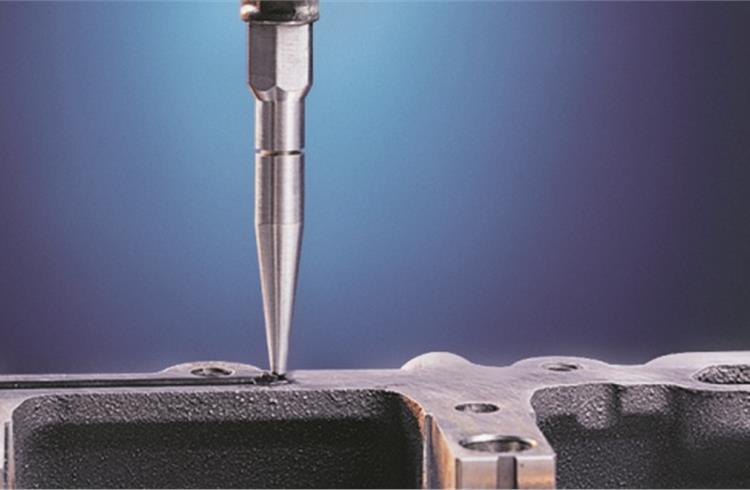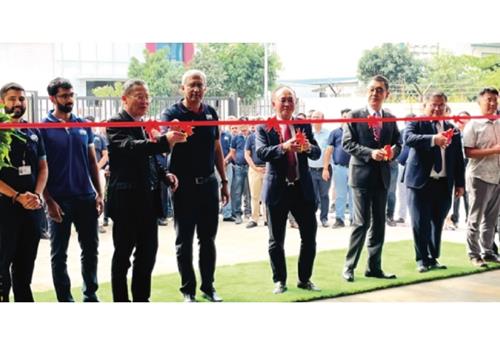Henkel looks to bond better with Indian automakers
The world’s largest adhesives-maker is benefiting from automakers’ drive to lightweight cars. While it faces cost pressures in India, working from an early stage of design with OEMs should help cut the kilos.
Maximising efficiency of resources and reducing CO2 emissions are among the biggest global megatrends today and one of the chief proponents of lightweighting.
Lightweight materials have become a crucial element for product design across several industries and in the automotive sector, shaving grams – and in turn many kilograms – in modern cars reduces fuel consumption which translates into lesser CO2 emissions and improved vehicle performance.
The automotive – along with aerospace – industry is a forerunner when it comes to the use of new lightweight materials. Leading automakers are constantly scouting and researching for innovative lightweighting solutions including the use of high-performing, modern adhesives. As OEMs increasingly take to using lighter materials like aluminium and polymer composites, which are not suited for welding, there is growing demand for high–performance adhesives or bonders. These modern, strong adhesives not only adroitly fill minuscule gaps in various car body sections but are also used to hold together and stiffen load-bearing parts.
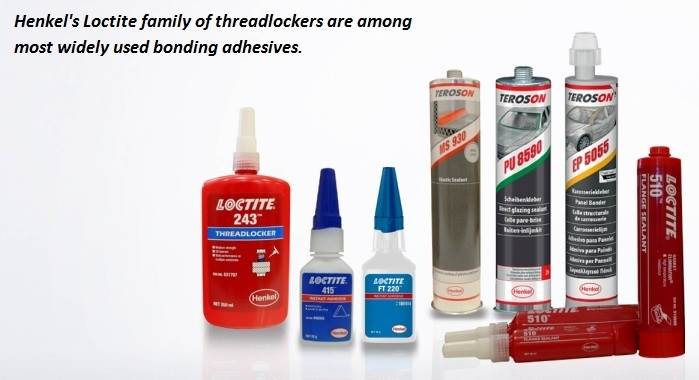
As consumers demand more mileage for their money, OEMs are actively engaged in driving development of low-cost, high-volume lightweight solutions. Demand for lightweight materials is growing sharply worldwide – Asia Pacific, which includes India, is thelargest market segment followed by Europe and North America.
In line with this burgeoning demand, German adhesives and functional coatings supplier Henkel is expanding its presence and services to cater to the Indian automotive industry.
The game’s Bond
The company, which set up an Innovation Centre in Pune in 2013, recently inaugurated an acoustics lab for NVH testing. Equipped with new acoustic NVH capabilities, the Center will provide a boost to the existing simulated environment for automotive, off-road equipment and appliance industry portfolio’s acoustic structures.
Henkel India has been ahead of the market in offering innovations which enable lightweighting and improvement in crash performance. Among the India-specific solutions is the use of structural adhesives as bonding solutions, which not only optimise but also provide an opportunity to eliminate spot welds and improve stiffness, fatigue and crash performance of vehicles.

Sprayable liquid applied sound damping significantly reduces structurally born noise.
Structural inserts as 3D parts help improve stiffness and crash of box sections like A, B and C pillars /sections by optimising steel design with weight reduction opportunities. Additionally, the company offers High Damping Foam (HDF) which improves door slamming and roof drumming noise with weight reduction opportunities. Liquid Applied Sound Deadeners (LASD), which are sprayable acoustic solutions, can replace traditional bitumen-based sheets, thus reducing process complexity as well as leading to weight reduction.
ARAI connect
Henkel India is also working with the Automotive Research Authority of India (ARAI) extensively to test and validate material solutions for effective crash safety performance. It is collaborating with the agency and some OEMs through tripartite ventures to validate materials for usage to enhance vehicle safety. Under these partnerships, the company is also exploring the use of different materials along with metals to enhance crash performance. Going forward, Henkel is looking to enter into more such partnerships to accelerate the adoption of lightweighting solutions which offer enhanced crash performance.
Last month, Henkel showcased some of its innovative adhesive technologies at the K2016 plastics trade fair in Germany. On display was an adhesive for joining a carbon fibre reinforced composite roof to a frame carrier made of thermoplastic. The adhesive, Loctite EA 9065, provides the high shear strength required for joining such important roof parts. It also bonds effectively many different substrates, including steel and aluminium, as well as fibre reinforced plastics or thermoplastic composites based on polyamides.
Loctite EA 9065 provides high crash durability and can be formulated for fast curing. Thus it is suitable for the automated application in large automotive production.
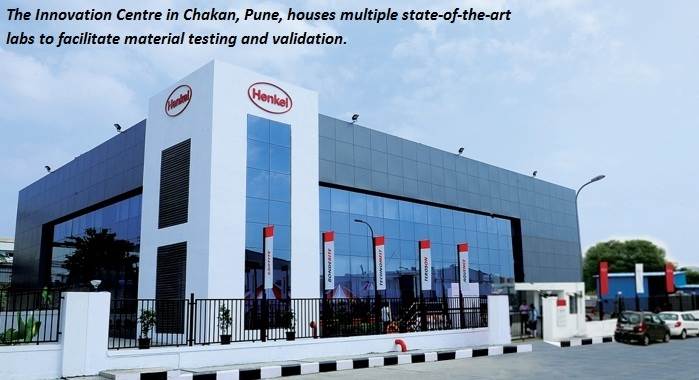
Apart from composite adhesives that can be tailored to specific resins, Henkel also produces matrix resins for various types of fibre and textile-reinforced composites, as well as binders and release agents. It backs up its product offering with in-depth technical service that includes process know-how and engineering as well as in-house testing capabilities for composites production.
Henkel India has collaborated on various projects with Indian OEMs such as Tata Motors, Mahindra & Mahindra, Skoda Auto India and VW India to name a few.
Going forward, as the country is set to adopt the new crash safety norms under Bharat NCAP, Henkel India’s automotive adhesive business is looking to capitalise by working closely with OEMs to help them meet the new safety standards. As vehicle and parts manufacturers in India explore the use of non-traditional, lighter but stronger composites and other material, demand can only grow for the likes of Henkel. For Indian automakers, it’s no longer a case of wait and watch. To shed vehicle weight, they need to bond. The solution is there and waiting.
INTERVIEW Shilip Kumar, President, Henkel India
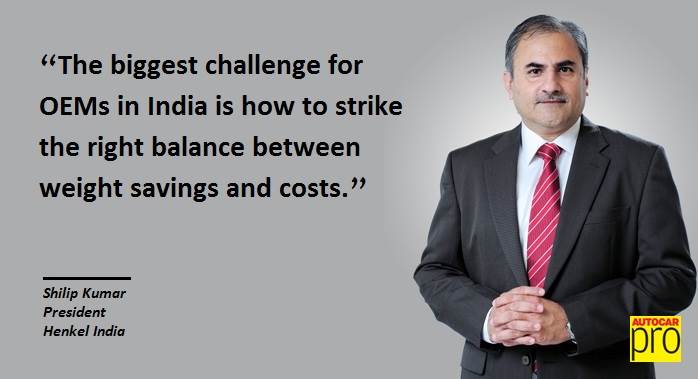
How is Henkel innovating with adhesives and polymers to cut weight?
Lightweighting now involves a lot of substrates, which is where we come in. We enable these new substrates to be integrated in the car body seamlessly. Our goal is to work very closely with customers since inception and jointly maximise the lightweight substrate with the right joining technique and reinforcement to get as much savings as possible on the car.
This comes at a certain cost but we work towards making it both economically viable and the process needs to be simple enough. We do not see ourselves providing a highly engineered solution that cannot be applied anywhere; it needs to be cost efficient.
Going forward, we believe that a car could weigh almost 30-40 percent less in the next 10 years. It will be a big evolution for the industry and it is great that we are a part of it.
What is the biggest hurdle for Indian OEMs when it comes to lightweighting?
The biggest challenge for OEMs in India is how to strike the right balance between weight savings and costs. What is the right price at which weight savings can be incorporated without exceeding the budget? We spend most of our days working on solutions to answer just that. If a technology costs say 2X, how do we bring the cost down involves a lot of value engineering, creativity of the chemists and the can-do attitude. We are currently working on a project which started at 3X; now after six months of real hard work by our engineers, and some support from Germany, we have got it to just 25 percent over the target. From 300 percent, it is now down to just 25 percent and this has been due to localisation to the extent possible, alternate raw materials that are easily available in India, and supplier partnerships where they help us with some really good ideas.
Going forward, how do you see the industry shaping up and how would lightweighting impact car designs of the future?
The beauty of the automotive industry is in the competition. Everybody is trying to raise the bar but by keeping affordability in check. In the mass market, companies ask what they can do that is better than the competition and still be affordable for consumers. That is really something which defines the pace at which progress happens. Expect to see more disruptors like Tesla going forward.
In a decade, would the car as we know it even exist? I think the discussions should now move from just cars to mobility. We do not know how the future will shape up mobility yet, but one thing is for certain — cars would be much lighter than they are today, efficiency would be much higher and emissions would be significantly lower than they are today, simply because of competition.
INTERVIEW: PK Verma, regional steering unit manager — Acoustic & Structural, IMEA
This feature was first published in Autocar Professional's November 1, 2016, 'Lightweighting Special' issue.
RELATED ARTICLES
BRANDED CONTENT: Serving India’s EV ecosystem
Shimnit Integrated Solutions Pvt. Ltd. (SISPL), a subsidiary of Mumbai's leading high-security number plate supplier, Sh...
Driving EV business with agility and flexibility
CEOs from the EV startup ecosystem met in Bengaluru and Pune to discuss the challenges and business opportunities.
BRANDED CONTENT: SM Auto and Gotech energy inaugurate their first battery pack assembly plant in Pune
Pune-based SM Auto Engineering (SMA), a leading automotive component system manufacturer and its partner Gotech Energy (...





 By Shourya Harwani
By Shourya Harwani
 17 Nov 2016
17 Nov 2016
 8647 Views
8647 Views



